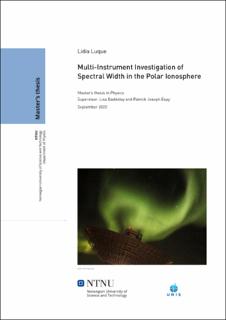| dc.contributor.advisor | Baddeley, Lisa | |
| dc.contributor.advisor | Espy, Patrick Joseph | |
| dc.contributor.author | Luque, Lidia | |
| dc.date.accessioned | 2022-02-02T18:20:37Z | |
| dc.date.available | 2022-02-02T18:20:37Z | |
| dc.date.issued | 2020 | |
| dc.identifier | no.ntnu:inspera:54708082:33513764 | |
| dc.identifier.uri | https://hdl.handle.net/11250/2976752 | |
| dc.description.abstract | Spektralbredden er en av parameterne målt av Super Dual Auroral Radar Network (SuperDARN) radarer. På tross av at de er mye brukt i litteraturen, er det foreløpig ikke enighet om årsaken til spektralbreddevariasjonene sett i den polare ionosphæren. Målet med denne oppgaven er å gi ytterligere innsikt i årsakene til spektralbreddevariasjonene, og spesielt i forholdet mellom spektralbredder og partikkelnedbør. Data fra tre instrumenter med overlappende synsfelt brukes til det formålet: Meridian Scanning Photometer (MSP) på Svalbard, European Incoherent Scatter Svalbard Radar (ESR) og SuperDARN Hankasalmi radar i Finland. Etter å ha behandlet en liste med over 200 hendelser for å finne hendelsene med samlokalisert data fra alle tre instrumenter, sitter vi igjen med 10 hendelser. Av disse behandles fire som casestudier, mens resten brukes i en statistisk studie. Vi finner at spektralbredden for disse hendelsene ikke er sterkt korrelert med elektrontemperaturene, som brukes som en ionosfærisk signatur av partikkelnedbør. Dette antyder at prosesser som ikke er relatert til partikkelnedbør forårsaker spektralbreddevariasjonene målt. Vi finner indikasjoner som peker på turbulens med varierende opprinnelse (bratte hastighetsforandringer, ion oppstrømning og «polar cap patches» som slås sammen med nordlysovalen) som årsak til høye spektralbredder i de fire casestudiene som er gjennomgått. | |
| dc.description.abstract | Spectral widths are one of the parameters measured by Super Dual Auroral Radar Network (SuperDARN) radars. Although they are extensively used in literature, there is currently no consensus on the cause of the spectral width variations seen in the polar ionosphere. The goal of this thesis is to provide further insight into the causes of the spectral width variations, and specifically into the relationship between spectral widths and particle precipitation. To that end, data from three instruments with overlapping fields of view are used: the Meridian Scanning Photometer (MSP) in Svalbard, the European Incoherent Scatter Svalbard Radar (ESR) and the SuperDARN Hankasalmi radar in Finland. After processing a list of over 200 events in order to find the events with co-located data from all three instruments, we are left with 10 events. Of those, four are treated as case studies, while the rest are used in a small statistical study. We find that, for these events, the spectral widths are not strongly correlated with the electron temperatures, which are used as an ionospheric signature of particle precipitation. This suggests that processes unrelated to particle precipitation are causing the spectral width variations detected. We find evidence pointing to the role of turbulence with varying origins (velocity shears, ion up-flow and polar cap patches merging with the auroral oval) as the cause of high spectral widths in the four case studies reviewed. | |
| dc.language | eng | |
| dc.publisher | NTNU | |
| dc.title | Multi-Instrument Investigation of Spectral Width in the Polar Ionosphere | |
| dc.type | Master thesis | |
